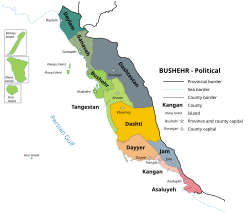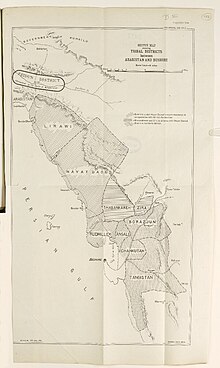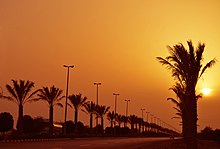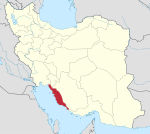Bushehr province
Persian: استان بوشهر | |
|---|---|
 Location of Bushehr province within Iran | |
 | |
| Coordinates: 28°50′N 50°50′E / 28.833°N 50.833°E[2] | |
| Country | Iran |
| Region | Region 2[1] |
| Capital | Bushehr |
| Counties | 10 |
| Government | |
| • Governor general | Arsalan Zare |
| Area | |
• Total | 22,743 km2 (8,781 sq mi) |
| Population (2016)[3] | |
• Total | 1,163,400 |
| • Density | 51/km2 (130/sq mi) |
| Time zone | UTC+03:30 (IRST) |
| Main language(s) | Persian, Luri,[4] Arabic and Turkic |
| HDI (2017) | 0.812[5] very high · 9th |
Bushehr province (Persian: استان بوشهر)[a] is one of the 31 provinces of Iran. It is in the south of the country, with a long coastline on the Persian Gulf. Its capital is the city of Bushehr.[6]
The province was made a part of Region 2 upon the division of the provinces into five regions, solely for coordination and development purposes, on 22 June 2014.[1]
History
[edit]The Greeks knew of Bushehr by Mezambria during the battles of Nearchus. A French excavating team however in 1913 determined the origin of Bushehr to date back to the Elamite Empire. A city there, known as Lyan, contained a temple that was designed to protect the compound from naval attacks. Its remains can still be seen today 10 kilometers south of the present city of Bushehr.
Marco Polo describes this region as part of the Persian province of Shabankareh. It contains the village of Saba, Iran where are buried (he was told) the three Magi which visited the Christ Child.
A key turning point in the history of Bor event of significance is known to have taken place in this region until the arrival of the European colonialists in the 16th century.
The Portuguese, invaded the city of Bushehr in 1506 and remained there until Shah Abbas Safavi defeated and liberated the Persian Gulf region of their presence. By 1734, Bushehr had once again risen to prominence due to Nader Shah of the Afsharid dynasty, and his military policies in The Persian Gulf.

Bushehr was selected by Nader to be the central base of Nader's Naval fleet in the Persian Gulf. He thus changed the name of the city to Bandar e Naderiyeh (Nader's Port). He hired an Englishman by the name of John Elton to help build his fleet. Dutch accounts report his naval fleet to have amounted to 8000-10000 personnel as well as several ship construction installations.
After Nader's death, the Dutch continued to have good commercial relations in Bushehr, until the British made their debut in Bushehr in 1763 by a contract they signed with Karim Khan of the Zand dynasty. By then, the city of Bushehr had become Iran's major port city in the Persian Gulf. By the Qajar era, Britain, Norway, Russia, Italy, France, Germany, and the Ottomans had diplomatic and commercial offices there, with Britain steadily gaining a foothold in the area. Close to 100 British ships are reported to have docked at the port city every year during the Qajar era.
2013 Bushehr earthquake
[edit]A strong earthquake measuring 6.1 on the Richter magnitude scale struck the town of Shonbeh and villages of Shonbeh and Tasuj District in Dashti County of Bushehr province on 9 April 2013, killing at least 37 people.[7]
Demographics
[edit]Language
[edit]A vast majority of the population speak Persian (mostly the Fars dialect) as first language with a minority of Arabic speakers.[8][9]
During the Safavid period, some people from the Kurdish Zanganeh tribe moved from Kermanshah to the villages between Ahram and Borazjan and formed a local government in this area, and from that time until the beginning of Qajar, this part of Bushehr province was called Zanganeh bloc.[10] The Zangeneh tribe have largely been assimilated and have adopted the local Persian and Turkic languages and are city-dwellers.
Religion
[edit]The vast majority of Bushehr's population are Shia Muslims, with a minority of Sunnis comprising 8.5% of the province's population.[12]
Population
[edit]At the time of the 2006 National Census, the province's population was 886,490 in 188,762 households.[13] The following census in 2011 counted 1,032,949 people in 246,742 households.[14] The 2016 census measured the population of the province as 1,163,400 inhabitants in 321,826 households.[3]
Administrative divisions
[edit]The population history and structural changes of Bushehr province's administrative divisions over three consecutive censuses are shown in the following table.
| Counties | 2006[13] | 2011[14] | 2016[3] |
|---|---|---|---|
| Asaluyeh[b] | — | — | 73,958 |
| Bushehr | 216,087 | 258,906 | 298,594 |
| Dashtestan | 222,226 | 229,425 | 252,047 |
| Dashti | 71,285 | 77,530 | 92,319 |
| Deylam | 29,079 | 31,570 | 34,828 |
| Deyr | 48,488 | 52,523 | 60,612 |
| Ganaveh | 82,937 | 90,493 | 102,484 |
| Jam | 37,999 | 51,446 | 70,051 |
| Kangan | 95,113 | 170,774 | 107,801 |
| Tangestan | 63,276 | 70,282 | 76,706 |
| Total | 866,490 | 1,032,949 | 1,163,400 |
Cities
[edit]According to the 2016 census, 835,955 people (over 71% of the population of Bushehr province) live in the following cities:[3]
| City | Population |
|---|---|
| Ab Pakhsh | 18,913 |
| Abad | 3,787 |
| Abdan | 6,827 |
| Ahram | 15,198 |
| Ali Shahr | 23,178 |
| Anarestan | 3,400 |
| Asaluyeh | 13,557 |
| Baduleh | 4,028 |
| Bandar Deylam | 25,730 |
| Bandar Ganaveh | 73,472 |
| Bandar Kangan | 60,187 |
| Bandar Rig | 6,252 |
| Bandar Siraf | 6,992 |
| Bandar-e Deyr | 24,083 |
| Bank | 14,126 |
| Bardestan | 7,112 |
| Borazjan | 110,567 |
| Bord Khun | 5,333 |
| Bushehr | 223,504 |
| Bushkan | 2,135 |
| Choghadak | 18,702 |
| Dalaki | 6,436 |
| Delvar | 4,442 |
| Dowrahak | 4,852 |
| Imam Hassan | 2,731 |
| Jam | 31,436 |
| Kaki | 12,119 |
| Kalameh | 2,463 |
| Kharg | 8,193 |
| Khormoj | 60,942 |
| Nakhl Taqi | 18,837 |
| Riz | 3,282 |
| Sadabad | 8,248 |
| Shabankareh | 7,900 |
| Shonbeh | 2,747 |
| Tang-e Eram | 3,242 |
| Vahdatiyeh | 11,222 |
Bushehr today
[edit]

Aside from the revived port city of Bushehr, which is the second main naval port of Iran after Bandar Abbas, Bushehr also has come back recently in the spotlight for three main reasons:
Kharg Island (Khark Island)
[edit]During the Iran-Iraq war, Iran's major petroleum exporting ports in Khuzestan sustained damages so severe that a second port in Kharg Island was selected to carry on the major responsibility of Iran's petroleum exports, though even Kharg was not immune from Iraqi air raids.
Bushehr Nuclear Reactor
[edit]The Bushehr Light water PWR Nuclear Reactor, designed by Siemens AG, built by the Russians, is Iran's first Nuclear Power Plant reactor.
The industrial corridor of Asaluyeh
[edit]As many as 70,000 foreign engineers and technicians are currently working in this industrial zone 270 kilometers south of the provincial capital. This zone is where the nearby famous South Pars Gas field is located, where Iran has invested hundreds of millions of dollars in infrastructure. The South Pars Gas field is the world's largest natural gas field.
The Asaluyeh industrial zone is deemed so lucrative that even American companies such as American Allied International Corp and Halliburton have bypassed American sanctions to become somehow involved in the zone.American Allied International Corporation – Assalouyeh
Sports
[edit]Football is the most popular sports in Boushehr. Boushehr is home to both famous football teams: Shahin-e Boushehr and Pars Jonoubi jam.
Shahin is one of the oldest soccer team in Iran which has found in 1942. Shahin is one of the most popular teams in current Iranian football league just like Tractor-Sazi from Tabriz.
Sajjad Gharibi (born 19 December 1991) is an Iranian bodybuilder.[16][17] He born on Khozestan, Ahwaz, and has lived in Busher. He has become famous in world because of his special physique. His musculus volume is extraordinary for his height, 186 cm (6'2" tall), and weight, 180 kg (390 lb). He has looked like The Incredible Hulk character, because of his size, his Iranian fans have called him Iranian Hulk.[18]
Literature
[edit]Bushehr has been home to some famous poets. Among them are Faiez Dashti (Dashtestani) (1830–1919) and Manouchehr Atashi. Faiez poems, and Dashti(or Dashtestani) literature in general, resemble Baba Taher's works. Sadeq Chubak, Najaf Daryabandari, and Moniro Ravanipour are among the most prominent writers in the literature of Bushehr.
Attractions
[edit]
The city of Bushehr has 3-star hotels, an airport, and modern amenities. The Cultural Heritage Organization of Iran lists up to 45 sites of historical and cultural significance in the province. Some are listed below:
- Persian Gulf Beach(Bushehr)
- Deje Borazjan
- Kakhe tauke (borazjan)
- Shahzade Ebrahim (Shazabreim)
- Qal'eh Holandiha (The Dutch Castle)
- Mabad Poseidon, (Poseidon's temple)
- Gurestan Bastani (the ancient cemetery)
- Imamzadeh Mir Mohammed Hanifeh
- Aramgah (tomb of) Haj Mohammed Ibrahim Esfahani
- The Old Church of Kharg Island
- Qavam water reservoir
- Qazi House
- Maqbareh (tomb of) the English General
- Shaykh Sadoon Mosque
- The Holy Christ Church
- House of Raies Ali Delvari
- House of Malik
- The ancient site of Ray-Shahr which is located 8 km south of Bushehr.
- Tomb of Abdul mohaymrn
- House Darya Baygui
- House of Dehdashti
- Castle of Khormuj
Colleges and universities
[edit]- Persian Gulf University
- Bushehr University of Medical Sciences
- Islamic Azad University of Bushehr
- Islamic Azad University of Borazjan
- Islamic Azad University of Shabankare
- Islamic Azad University of Khormuj
- Islamic Azad University of Khark
- Iran Nuclear Energy College
- Payame Noor University of Bushehr
See also
[edit]![]() Media related to Bushehr Province at Wikimedia Commons
Media related to Bushehr Province at Wikimedia Commons
Notes
[edit]- ^ Also romanized as Ostān-e Būšehr
- ^ Separated from Kangan County after the 2011 census<[15]
References
[edit]- ^ a b "استانهای کشور به ۵ منطقه تقسیم شدند". همشهری آنلاین (in Persian). 22 June 2014. Retrieved 25 April 2022.
- ^ OpenStreetMap contributors (24 August 2024). "Bushehr Province" (Map). openstreetmap.org (OpenStreetMap) (in Persian). Retrieved 24 August 2024.
- ^ a b c d Census of the Islamic Republic of Iran, 1395 (2016): Bushehr Province. amar.org.ir (Report) (in Persian). The Statistical Center of Iran. Archived from the original (Excel) on 3 August 2017. Retrieved 19 December 2022.
- ^ "Luri (لوری)". Omniglot. Archived from the original on 24 May 2024.
- ^ "Sub-national HDI – Area Database – Global Data Lab". hdi.globaldatalab.org. Retrieved 13 September 2018.
- ^ Habibi, Hassan (c. 2024) [Approved 21 June 1369]. Approval of the organization and chain of citizenship of elements and units of the national divisions of Bushehr province centered on Bushehr city. lamtakam.com (Report) (in Persian). Ministry of the Interior, Political Defense Commission of the Government Board. Notification 82824/T138K. Archived from the original on 24 April 2024. Retrieved 24 April 2024 – via Lam ta Kam.
- ^ "Iran quake kills 37, injures more than 850". CNN. 9 April 2013. Retrieved 19 December 2022.
- ^ "Language distribution: Bushehr Province". Atlas of the Languages of Iran (ALI). Retrieved 27 April 2022.
- ^ Anonby, Erik & Taheri-Ardali, Mortaza, et al. (eds.). 2015–2022. Atlas of the Languages of Iran (ALI). Ottawa: Geomatics & Cartographic Research Centre, Carleton University. (http://iranatlas.net/) (Accessed 2022-04-27).
- ^ "تاريخچه شهرستان تنگستان".
- ^ "Language distribution: Bushehr province". 2022. Retrieved 11 April 2022.
- ^ "فضای صمیمی بین اهل سنت و شیعه در استان بوشهر وجود دارد" [There is an intimate atmosphere between Sunnis and Shias in Bushehr province]. Mehr News Agency (in Persian). 10 March 2022. Retrieved 2 August 2022.
- ^ a b Census of the Islamic Republic of Iran, 1385 (2006): Bushehr Province. amar.org.ir (Report) (in Persian). The Statistical Center of Iran. Archived from the original (Excel) on 20 September 2011. Retrieved 25 September 2022.
- ^ a b Census of the Islamic Republic of Iran, 1390 (2011): Bushehr Province. irandataportal.syr.edu (Report) (in Persian). The Statistical Center of Iran. Archived from the original (Excel) on 3 April 2023. Retrieved 19 December 2022 – via Iran Data Portal, Syracuse University.
- ^ Rahimi, Mohammad Reza (c. 2013) [Approved 29 September 2013]. Approval letter regarding country divisions in Bushehr province. rc.majlis.ir (Report) (in Persian). Ministry of the Interior, Council of Ministers. Notification 200653/T46432 AH. Archived from the original on 10 January 2013. Retrieved 29 March 2023 – via Islamic Parliament Research Center of the Islamic Republic of Iran.
- ^ "'Scariest Man on the Planet' to fight 'Iranian Hulk' in MMA debut". talksport. 22 November 2018. Retrieved 25 May 2019.
- ^ "178kg monster is an absolute weapon". news.com.au. 23 November 2018. Retrieved 25 May 2019.
- ^ "همه چیز درباره چهره شاخص این روزهای فضای مجازی". tasnimnews.com. Tasnimnews. 31 May 2016. Retrieved 25 May 2019.
External links
[edit]- Bushehr Cultural Heritage Organization
- Iran Oil Terminals Company
- Iran Petrochemical Commercial Company Archived 2011-02-07 at the Wayback Machine
- Pars Special Economic Energy Zone
- National Iranian Gas Company
- National Petrochemical Company of Iran Archived 2017-07-04 at the Wayback Machine
- Bushehr Province Department of Education (in Persian)
- Official website of Shahin Club (in Persian)
- Iranian textbooks On Bushehr province (in Persian)




